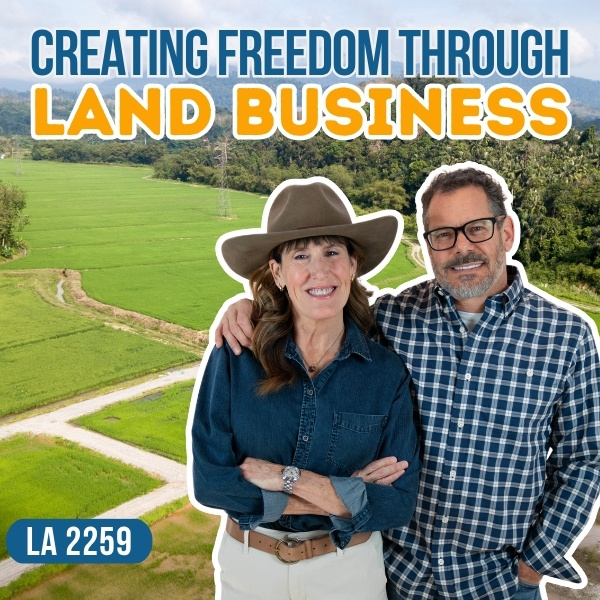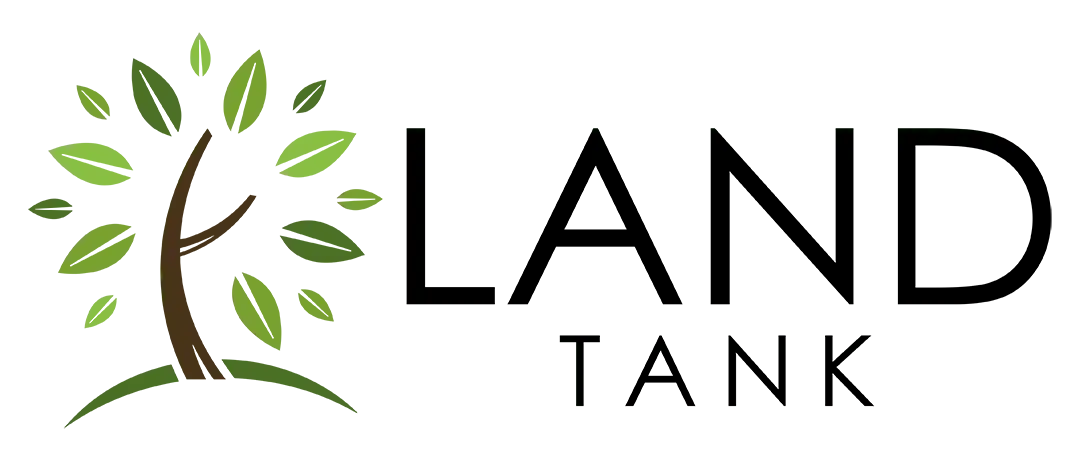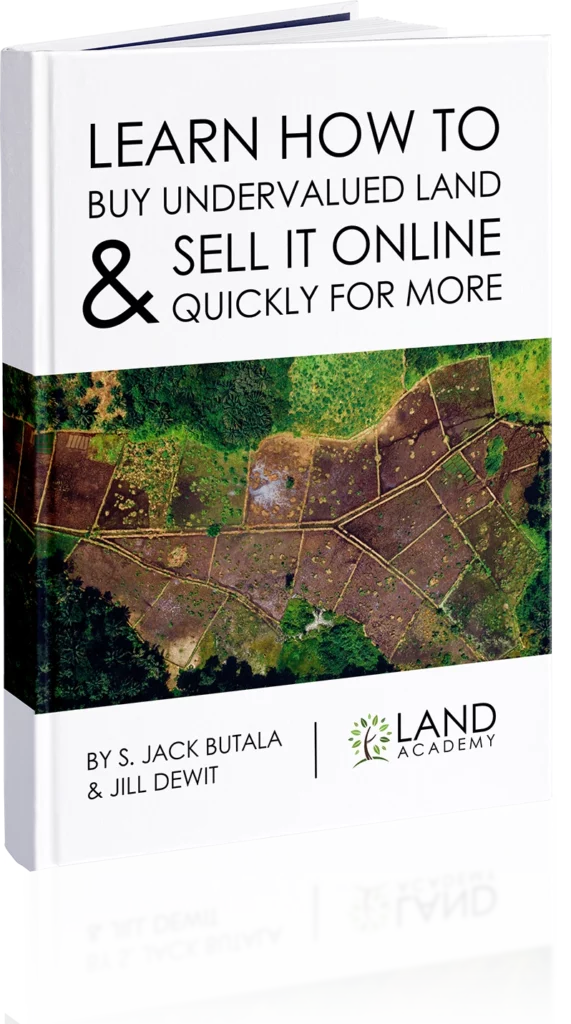3 Types of Land Investment Deal Buckets (LA 1734)
3 Types of Land Investment Deal Buckets (LA 1734)
Transcript:
Steven Jack Butala:
Steve and Jill here.
Jill K DeWit:
Hi.
Steven Jack Butala:
Welcome to the Land Academy Show, entertaining land investment talk. I’m Steven Jack Butala.
Jill K DeWit:
And I’m Jill DeWit, broadcasting from the valley of the sun.
Steven Jack Butala:
Today Jill and I talk about the three types of land investment deal buckets that we kind of live by.
Jill K DeWit:
Yep. I think it’s interesting that … These change by the way. You’re one, two, and three different kind of buckets that you’re working with, and properties, and prices. It’s going to change and evolve.
If you know us, you’ve learned that over the years if, and heaven forbid you’ve been watching us and following us for the seven years we’ve been doing this. But we-
Steven Jack Butala:
Yeah that’s [crosstalk 00:00:38]
Jill K DeWit:
– are getting really good at eating our words. We at one time were going to do a whole separate podcast on poor broker agent bashing, and now we love them. So when you hear us talk about these buckets, know there’s an ebb and a flow, and things change. And there’s no wrong way.
Steven Jack Butala:
I named them buckets for a reason, and we’ll get into it in detail here in a minute. The buckets themselves, the holder, never change. The stuff that goes inside changes.
Jill K DeWit:
I thought becoming a parent and eating my words there was enough. But oh no, there’s age and experience eating of words that goes on. I’m sure that when we’re 80 I’m going to go, “Oh we are so wrong,” and we’re going to be eating our words again.
Steven Jack Butala:
Yeah. It’s not the opposite actually, it’s like the older we get the more I don’t think I’m smart. I get like not-
Jill K DeWit:
You get stupid again?
Steven Jack Butala:
– I get less intelligent and less knowledgeable about … I think most people get older and they get real set in their ways, and say “this is it.” For some reason, I’m going the other way.
Jill K DeWit:
That’s true. That’s very true.
Steven Jack Butala:
Before we get into it, let’s take a question posted by one of our Land Investor members on our online community. It’s free. Did you know that we have a full blown, operational commercial printing company called offers2owners.com. Jill and I set this company up several years ago to specifically mail out our blind offer campaigns. We started sharing it with our members –
Jill K DeWit:
And the public.
Steven Jack Butala:
– and some non-members, yeah, a couple years ago. Today we mail out between 700,000 and 800,000 offers a month on their behalf. Give them a call, 800-725-8816, or support@offers2owners.com.
Jill K DeWit:
It’s offers, and the number two, and then owners.com.
Erin wrote, “How do you know if a property’s an infill lot?”
Steven Jack Butala:
Here’s how. It’s actually quite simple. It’s a very good, simple question. An infill lot has properties … You know what an infill lot is going to be used for. How do you know that? Because the stuff that’s around it or adjacent to it, hopefully adjacent to it, is developed that way. And it’s almost always houses.
It might be, in some cases, a strip mall. But it’s an infill lot, and not a piece of real vacant land. Or we don’t know exactly how it’s going to be developed because it’s really far out from any type of urban center. If it’s within an urban center or close to it, and there’s houses all around it, you know it’s going to be used to build another house. That’s an infill lot, it’s being infilled.
Jill K DeWit:
Like it’s in a subdivision.
Steven Jack Butala:
Yeah, it’s a great example. 98 percent of them are in subdivisions. An incomplete subdivision and there’s a lot that needs to have a house on it just like next door.
Jill K DeWit:
Mm-hmm (affirmative), thank you.
Steven Jack Butala:
Real easy to value. Real easy to sell. You sell it to the person who … The developers who built all the other houses around that lot, around that area. It’s got a very specific market value that’s tied to what a house is worth when it’s completed.
Jill K DeWit:
Let me save you some headache. Don’t buy it if there are already 45 available for sale in that area.
Steven Jack Butala:
Yeah.
Jill K DeWit:
You don’t want to jump into that pool.
Steven Jack Butala:
In a perfect world, Jill’s exactly right, you want to buy the last lot. It’s just one more house waiting to be built, or the last 10 lots.
Jill K DeWit:
And these people have been hanging onto it lovingly. Now’s the time … They’re not going to build it, their kids don’t want to live there after all because they don’t want to be that close to mom and dad, and you scoop it up. That’s the one you want.
Steven Jack Butala:
Land Academy 1.0? Yeah, Land Academy 1.0 is devoted –
Jill K DeWit:
To infill lots.
Steven Jack Butala:
… 100 percent. It’s called Infill Lots. If you remember, check that out because it explains all of this in an incredible amount of detail.
Today’s topic, the three types of land investment bucket deals. This is why you’re listening. Quite some time ago … I’m always searching for easy ways to understand what ends up being a pretty complicated topic. You know, this buying and selling of real estate. So I kind of took a few steps back. About three or four, maybe six, months ago, and looked at the deals that Jill and I do. I put them into three buckets, and here they are.
Jill’s going to say, “Yeah, that’s not really what I think,” in a minute here. I can tell.
Jill K DeWit:
Oh my god.
Steven Jack Butala:
She’s flipping through papers.
Jill K DeWit:
Oh, I’m [crosstalk 00:05:15].
Steven Jack Butala:
Bucket number one is buying a piece of land, and reselling it for more. You’re never going to see it. It’s never leaving your desk. This is the bread and butter, vanilla flavored Land Academy text book transaction. In our case right now, we buy it for $20,000 or $30,000, and sell it for $60,000 or $70,000.
When we started we were buying bucket one property. We were buying for, geez, $500 to $800 and selling it for $1500. So the bucket itself has always been the same, but what we’re filling it with, the type of transaction that we’re filling the bucket with is a little bit different. The numbers are a little bit different. Maybe the areas that we do it in, geographically, are a different, but it’s still bucket one property. Buy a piece of property, resell it.
Bucket two. Do you want to talk about this one?
Jill K DeWit:
No, go ahead.
Steven Jack Butala:
Bucket two –
Jill K DeWit:
I’m going to let you keep going.
Steven Jack Butala:
Bucket two property is buy it real cheap, but you know you’re going to have to do some stuff to it. I don’t mean build a skyscraper, I mean it might have legal access. You can see it, and everybody agrees it’s got legal access, but to give it its value, its true value, wholesale value, you might have to blade a road in. Or you might have to file some papers at the county that says, yeah Farmer John’s said that there’s access. I heard there’s access, but we got to go through this to make sure that it’s all legal and it’s written in the deed, and the easement’s correct.
So it takes a little bit of work to get it to where it’s sellable. We do a lot less deals like this than we do bucket one.
Jill K DeWit:
[crosstalk 00:06:56] going to add. It’s probably less than 10 percent.
Steven Jack Butala:
Yeah.
Jill K DeWit:
It’s very rare.
Steven Jack Butala:
Five to ten percent in a given year. Sometimes zero.
Jill K DeWit:
I don’t want to do it. So I’m not eating my words on this one when I say don’t run out and get a survey. Do you need a survey?
Steven Jack Butala:
Survey’s a great example of a bucket two property.
Jill K DeWit:
We’ve talked to people that were accidentally thinking that you had to get a survey on every property. You don’t need to do that. I mean, you can do that, but it’s going to spend a lot of money for a lot of people that don’t care about it.
Steven Jack Butala:
That’s great, Jack. Why would you ever do a bucket two property then? Here’s why. Because when we send this mail out and it all comes back, we don’t do a bucket three mailer or a bucket one mailer, or a bucket two. We send it all out, it comes back. Then Jill and I stare at it and say –
Jill K DeWit:
“What’s the best used?”
Steven Jack Butala:
Well, we’re going to pay 30 grand for this property. We all know that, and they’ve agreed. The sellers agreed. We know if it’s a bucket one property you can sell it for 60 or 70. Yeah, if we do some stuff to it. There’s a little clearing over here, put a shed out there, we could probably get a lot more money. We probably sell this for $90,000 to $100,000.
So we shove it into bucket two. We both accept the fact that it’s going to take a little bit of work and some time, or whatever. And we soak a little bit more money out of the deal.
Jill K DeWit:
I’m sorry. When you say, “We both accept,” let’s be truth … Truth time again. Jack accepts it. Nothing’s ever fast enough for Jack.
Steven Jack Butala:
That’s true.
Jill K DeWit:
Jack says, “Okay, fine.” One of us has patience.
Steven Jack Butala:
Or we have to get a survey. Especially in this day and age, they cost 10 grand and take six months. When I started doing this, a survey could happen the next day, and it was $1200. So you have to weigh that, you have to weigh the time and the profit margin benefit.
Jill K DeWit:
Okay.
Steven Jack Butala:
Bucket three property is taking that bucket two property concept about improvement and taking it way farther than that. That’s doing a minor split. A lot of places in the country will allow you to take one APN, one property, and split it down into smaller parcels if you do certain stuff. And that takes a year at least.
There’s all kinds of stuff involved. But now that bucket one property that you’re paying $30,000 for, at the end of the year when it’s all done might be worth $300,000 or $400,000. So you have to decide which bucket these properties fall in. Or, and this is the beauty of this business, you can decide to stick your middle finger up to all of this and say every single property’s a bucket one property.
Jill K DeWit:
Right.
Steven Jack Butala:
And that’s it. I’m want to buy it for 30 and sell it for 80.
Jill K DeWit:
I see bucket one as our regular land deals, which includes deal funding too, by the way. That’s our bucket one stuff. It could be bucket two, but Jack likes to see it as a bucket one.
Number two, am I going to split it up, do it lightly? Blade in a road? Number three is kind of develop it in some way. Maybe I pop a shed on it, I don’t know, make it stand out in some way that’s really, really unique and cool and good because it makes money.
I’m also going to add … So that’s what we’re doing now. I was saying, this stuff changes. So for someone brand new, you’re starting out, what should your buckets look like? Right? Here’s how I envisioned it. Your buckets are going to be money driven, not necessarily type driven. I think you’re going to evolve to that. Part of it is too, because your niche and your type is going to find you.
When I describe these three buckets, you may be happy with these three buckets forever, and that’s all you’re doing. Maybe your bucket one is what you start out on. Lower dollar deals because that’s your comfort zone. A lot of people start there and it’s great. Maybe they’re thousand dollar deals. Buy them for one, sell them for eight. Do that for awhile, I don’t know.
Roll in bucket two. Part of this is tied to the interview that you’re going to hear tomorrow with Brandon Coon. He talks about that’s how he started out. So he has some great stories and examples of this. You’ll hear it tomorrow.
Then bucket two is, maybe these will be a little more expensive. Five thousand dollar deals, buy them for five, sell them for fifteen. That’s your bucket two. I don’t do as many of those, more money’s involved, and I’m just being –
Steven Jack Butala:
So you’re changing the buckets?
Jill K DeWit:
I’m talking about a new person and how their buckets can evolve.
Steven Jack Butala:
If you’re going to buy it and resell it, then it’s all bucket one.
Jill K DeWit:
Well, that’s how you see that, Jack.
Steven Jack Butala:
No, that’s how we teach it in the program, Jill.
Jill K DeWit:
Well I know, but I’m just saying you can … You know what? That’s a great thing about this program, make it your own. I’m making this podcast my own.
Steven Jack Butala:
Clearly.
Jill K DeWit:
I think bucket three could be bigger deals and buying for 15, 20, 30 thousand dollar deals. I don’t do many of those because I’m brand new, and I’m probably not even using my money. So maybe that’s my personal bucket three is not my money deals. Somebody else is funding them, and I think of those a different way. And then it just evolves.
Thank you for sharing. My partner doesn’t agree.
Steven Jack Butala:
You just blew my whole three bucket concept completely out of the water.
Jill K DeWit:
Because your buckets are different than my buckets. Why do they have to be the same?
Steven Jack Butala:
Bucket one property is buy the land and sell for more. It might be a $500,000 that you sell for $600,000. The bucket’s the same. The type of deal that you put in the bucket is what is variable.
Jill K DeWit:
Okay.
Steven Jack Butala:
We have made, all kidding aside –
Jill K DeWit:
Forget the buckets. Kick the buckets. Don’t kick the [crosstalk 00:12:31]-
Steven Jack Butala:
Jill and I have made bucket one property our career, and that’s what we teach. A very, very small percentage of properties reach it to two. In reality here’s what happens when we decide to do a bucket two property.
We get a property in that doesn’t appear to have access, which happens often. So we have a choice. We can pass on it or we can choose to get it so cheap. Jill will go back and say this property doesn’t have access, but she happens to know … This is a real example. Happens to make two phone calls to the surrounding owners of property that say, “Oh yeah, sure [crosstalk 00:13:05] we’ll grant you access. You don’t even have to pay us. Just send me the paperwork, I’ll sign it.”
So now we’ve got a piece of property that has very little value in its exact present form and present state, physically. But with the stroke of a pen and a few things that the neighbors are willing to do and happy to do, now it’s got access. So we turn that property into some serious value. It doesn’t happen all the time, but it does happen, and that’s my bucket two.
Bucket three is … And we have several bucket three properties going on right now where we’re minor splitting it, and getting it ready for mobile homes to be put on the property, and then selling it to the person who’s going to do that.
So, Jill has obviously a little bit of definition I’m learning today.
Jill K DeWit:
And that’s okay. You should too. Happy you could join us today.
Steven Jack Butala:
Wait [crosstalk 00:13:55] aware of this, that’s all. We’re not saying you should do one or the other.
Jill K DeWit:
No, no.
Steven Jack Butala:
I’ll tell you … I’ll end on this. In career path this is a big topic. Because there are people that come to us, a lot of people that come to us, who are bucket three people and that’s it. They only ever want to subdivide property and put stuff on it, and really do a couple deals a year and make a couple million bucks a year. That’s okay, that’s great. That’s just not … We’re bucket one people.
Jill K DeWit:
Cool. Happy you could join us today. Five days a week you can find us here on the Land Academy Show.
Steven Jack Butala:
Tomorrow, the episode on Land Academy Show is called … We interview, like Jill said earlier, Brandon Coon, who’s a very successful long time Land Academy member. We had a lot [crosstalk 00:14:39] –
Jill K DeWit:
It’s awesome.
Steven Jack Butala:
… of fun doing it. It’s a great show.
Jill K DeWit:
Yeah. And a former career path member, and now a career path helper.
Steven Jack Butala:
Yep, career path helper. You’re not alone in your real estate ambition. That was fun Jill. It was fun to disagree with you right in front of a camera.
Jill K DeWit:
You said I’m allowed to have my own buckets, and I have my own buckets. So, I have my own buckets.
Steven Jack Butala:
You’re allowed to do anything you want –
Jill K DeWit:
I am.
Steven Jack Butala:
… after the amount of stuff that you sold this month.
Jill K DeWit:
Thank you.
Steven Jack Butala:
Baby –
Jill K DeWit:
I’m changing the whole buckets. You know what? Now they’re baskets. You know what? How about this? You have your own darn buckets. You can take your buckets and do what you want with them. Mine are pretty baskets with flowers in them, and we’re over here killing it.
Steven Jack Butala:
[crosstalk 00:15:18] Buckets and baskets.
Jill K DeWit:
That’s right.
Steven Jack Butala:
That’s what we should have called this.
Jill K DeWit:
Exactly, and now we will. Thank you for tuning in. Jack and I are very aware not every one has 100 grand lying around to buy land. Well, don’t worry because we fund many deals. Whether you’re a Land Academy or not, we are happy to fund your deals. Check out landfunding.com. In addition to us, there’s a whole group of investors involved with Land Academy. We’ve got … Should I say that number?
Steven Jack Butala:
Yeah, sure.
Jill K DeWit:
All right. Combined, to date, the last time we checked was about 40 million dollars to fund. This is not a loan, by the way, it’s a person that’s going to partner with you and they’re going to fund your deal. It’s not like a percentage thing. So check out our website and you’ll find more. Or email support@landacademy.com.
Steven Jack Butala:
We’re Jack and Jill.
Jill K DeWit:
We’re Jack and Jill.
Steven Jack Butala:
Information.
Jill K DeWit:
And inspiration.
Steven Jack Butala:
To buy undervalued property.
If you enjoyed the podcast, please review it in Apple Podcasts . Reviews are incredibly important for rankings on Apple Podcasts. My staff and I read each and every one.
If you have any questions or comments, please feel free to email me directly at steven@BuWit.com.
The BuWit Family of Companies include:
I would like to think it’s entertaining and informative and in the end profitable.
And finally, don’t forget to subscribe to the show on Apple Podcasts.















